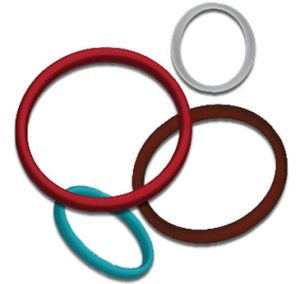
Fluorosilicone is a common material used in the construction of O-rings. It’s essentially a hybrid of the materials silicone and fluoroelastomer. These two synthetic materials are blended together to form a new material known as fluorosilicone with improved properties. What are the pros and cons of fluorosilicone O-rings exactly?
Pro: Heat and Cold Resistant
You can use fluorosilicone O-rings in both hot and cold environments. Extreme temperatures can cause other materials to fail. Extreme heat, for instance, may cause O-rings made of materials to melt, whereas extreme cold may cause them to crack. Fluorosilicone O-rings, however, can handle extreme temperatures without failing.
Pro: Excellent Release From Sticking
Fluorosilicone O-rings offer excellent release from sticking. Like most O-rings, they are used to seal mating surfaces, such as the space around a shaft or cylindrical part. Even when compressed, however, they are easy to release from these mating surfaces.
Pro: Low Compression Set
Fluorosilicone O-rings have a low compression set. They are typically compressed when exposed to pressurized gas or fluid. A low compression set, though, means they will retain their original size and shape — even after being compressed for extended periods.
Pro: Resistant to Sunlight
When choosing O-rings to use outdoors, you should consider whether they are susceptible to sunlight-related degradation. Some types of materials can degrade and fail when exposed to sunlight. Prolonged exposure to sunlight will cause them to dry out, shrink and crack, at which point the O-ring will no longer provide an airtight seal. But fluorosilicone O-rings are resistant to sunlight. You can use them in direct sunlight without fear of them failing.
Con: Lower Tensile Strength
Fluorosilicone O-rings have a lower tensile strength than certain other types of O-rings, such as nitrile and EPDM. This means they are more likely to tear under physical stress. For high-stress applications, you may want to choose an O-ring made of a different, stronger material.
Con: Cost
Another potential disadvantage of fluorosilicone O-ring is the cost. They typically cost more than other types of O-rings. Fluorosilicone is a complex hybrid material consisting of silicone and fluoroelastomer. Due to the complexity of producing it, O-rings made of this material typically come with a higher price tag.
In Conclusion
O-rings are available in many different materials, one of which is fluorosilicone. Fluorosilicone O-rings are hot and cold resistant, offer excellent release from sticking, have a low compression set, and they are resistant to sunlight. On the other hand, though, they have a lower tensile strength than many other O-ring materials, and they typically cost more.
